Aku meditasi dalam keriuhan kebingungan
Terjun, kata Mereka. Terjun!
Maka Aku Terjun.
Fluks masa dan ruang menelanku
-dalam kelajuan cahaya itu aku terapung
Seram-Sejuk-Pedih-Nikmat-Gelap-Terang
Tembakan bintang-bintang pancawarna lurus memancar kelilingku
Di sini mulanya carikkan roh dari jasadku
Tapi aku gelisah dalam kengerian berat graviti ini
Kerana, ada ketenangan
– Memori.
Singulariti titik-titik keindahan, kebebasan
Jelasnya – seakan supernova sekelip mata
Kelirunya – akan seperti terbitnya cahaya Oksidental
Ku rapatkannya ke dada dan senyuman tersimpul
Tercerna jua ia dalam kekesalan yang mahaberat
Maka tercerailah aku dari rohku itu
Terledaklah ia dalam rusuk busukku yang kosong
---
Tapi Aku terus hidup.
Atau ….
Sunday, 4 April 2010
Bunuh roh itu.
Monday, 9 November 2009
Cairo
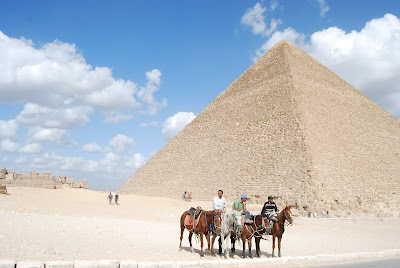
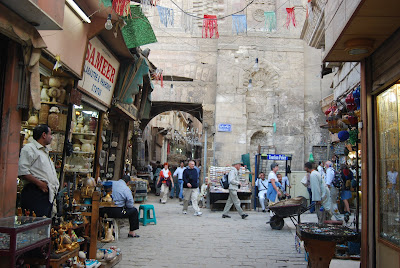










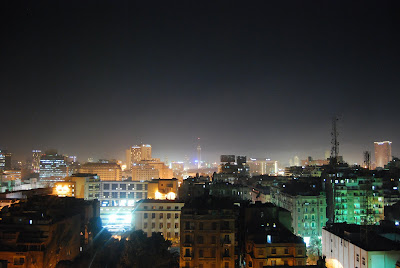
The Red Sea crossing between Aqaba in Jordan to Nuweiba in Egypt was slow and eventful (our ferry was drifting along the coast of Nuweiba aimlessly. There was something close to a riot on the boat as people were sick and tired of being left uninformed). In Nuweiba I had to wait for the bus to get full, I was getting a bit impatient and kept on going to the bus operator hassling them to start the engine. The tiredness of travelling since 5am was taking its toll on me.
I got to Cairo at 3am the next day. There were several taxi drivers trying to get me into their taxis but the competition wasn't so fierce and I was too tired to be cutthroat with my haggling. Paid a little bit more than I should for taxi to town but when I realised how far away I was from Downtown Cairo, I didn't mind. At 3am, Cairo was a serene place. Maybe it's good that I was spared the chaos during that desperate state of mind. I couldn't handle anymore stress!
By next morning, Cairo had awoken to its famous chaotic personality. The city streets roared with millions of cars, people and donkey carts. The shops and the sellers added to the symphony of light, color and noise. It was a truly exciting place. Downtown Cairo, where I stayed, was a beautiful district built in the late 19th-century in the image of Paris. Now the glamour is all but lost as the upper classes left for suburban dreams in the periphery of Cairo. But life goes on. The Beaux-Arts axial street plans had morphed into what seemed like a wide and colourful grand souq devoid of the orderliness and serenity of the European city of the 1930s. I have a soft spot for chaotic (but choreographed!) big cities with a mix of contradictions like London, Berlin and perhaps Istanbul so I fell in love with Cairo almost instantaneously. However this city is not for the fainthearted.
There are a lot of scams here. Whatever you're trying to buy or wherever you go, you have to take that extra precaution to double check what you're getting for and how much! You also need to learn to say NO in a decisive manner. On the way to the Pyramids, my taxi was stopped midway by a strange guy who then went on to say the road to the Pyramid is closed and somehow explained that I need to come with him on a donkey or something. By then I was more than prepared for such scams, I said no despite the aggressive persuasions and told the taxi driver to drive. Had he not driven me where I wanted to stop, I wouldn't have paid him a penny. Obviously the road to the Pyramids was fine and I got there without any problems. This kind of scams are so common in Egypt nowadays they have it in the travel guidebooks.
By now I have mastered how to deal with the sly and cunning ways of the Arab sellers. (If they say it's 100pounds, I'll say it's 2pounds, much to their disbelief). I let them assume that I either have the soft heart of the easily bullied Europeans or the moneyed and overly trusting Japanese tourist. Little did they know that Malaysians are ruthless hagglers and we are masters of deceit. We rarely let our sentiments or feelings known, so it's harder to deal with us. (Give the price, say NO! and walk away pretending not to care. Never smile).
What frustrated me the most was that I couldn't make sense of the streets in Downtown. I always got lost. In fact I got lost everyday - even with a map! I usually navigate with landmarks rather than remembering the streets. My brain function somehow dedicated less power to the lefts and rights in the directions. This worked in all other places so far but Downtown Cairo was probably the most confusing place for me. The streets all look the same, sound the same and have more or less same shops. The landmarks at each end of the road are the same as well because they all converge into one (somehow!). To make things worse, a lot of Arabs seem to have the problem of not being able to admit that they don't know something (especially the men). So I sometimes was sent to a wild goose chase all over the city. I was so angry with myself sometimes I lost the mood to do anything and just ended up sitting in any tea shop or internet cafe I saw.
There's always something to do in Cairo. Although not built during the Pharonic times, Cairo is an ancient city rich with history. The famous Pyramids are quite close by but they're in the neighbouring city of Giza. I did the Pyramids on my first day where I met the Aussie who came with me to Syria. It's very touristy here, needless to mention, but I was glad the tourists (euphemism for uninterested tour groups) stayed close to the Sphinx and left the rest of the vast area untouched. I took a horse ride (touristy! had to, it was really hot that day) to the area further into the desert to have a view of all three pyramids.
Egypt definitely understands the importance of its heritage. You can see how the regeneration projects in the historic areas are reaping the benefits from not just tourism but better quality of life for residents. I was surprised with the level of development in Egypt, it seemed like the country is growing quite rapidly. Compared to Syria and Jordan, constructions seem to be everywhere. Khan al-Khalili, or the "Islamic Cairo", was sensitively restored and now a pleasant strollable area. While retaining the clutter of the goods and chaos of the traditional Arab souq, it was devoid of the pollution and rubbish also typical of Arab cities. There are so many historic and beautiful mosques, madrasas and hamams in the whole district, you wonder no more why Cairo is called the city of thousand minarets.
Monday, 2 November 2009
Petra







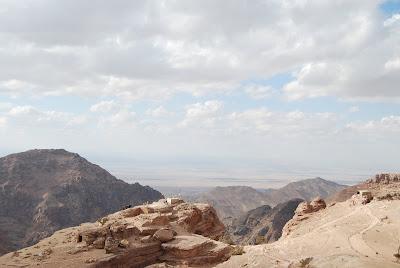
No visit to Jordan is going to be complete without Petra. This ancient city definitely lived up to the hype. Everyone who's been raved about it so much so it made me a little bit nervous about whether it really is as good as it sounds. The Malay phrase "Indah khabar dari rupa" (Sounds better than it looks) kept on playing on my mind, readying me for a disappointment. But of course it didn't disappoint. This place is so magical. It's literally a whole city built into canyons and rock formations. The crowds of tourists and the souvenir stalls (in the style of traditional Bedouin tent) didn't bother me either, it's great to have a lot of people and tents around. It made Petra seemed like a real living city.
The Dead Sea

Amman
A the hostel in Damascus, a Canadian managed to convince me to come with him to Amman. I was planning to go on that day but not that early in the morning. He said the border formalities would take ages (which it did) and was shocked to learn that I was planning to go at night. As it turned out we met other people who were going to Jordan that day. So getting a shared taxi to Amman was easy.
Our taxi driver was a right dodgy one. It seemed like he was using the opportunity to smuggle all the duty free stuff into Jordan. At the Syrian border he bought cartons of ciggarettes (more than allowed) and bought more when we got to the Jordanian side. To make sure he hadn't miss out on anything, he bought a big bottle of whiskey as well. He even slipped some money in his passport for the border guards. The ciggarette cartons were unpacked and stuffed into his socks. The remaining was given to us so that we pretend it was ours. The whiskey was not his, he said. "Pretend it's yours". He was hoping to keep up the pious Arab facade for the general public. Everything was done in a systematic fashion, with an efficiency I thought could never occur in the Arab World.
Once in Jordan, he refused to drive us to our hotel and dropped us off instead in the middle of Downtown Amman. He was really rude about it - he got out of the car and took our stuff out. To add to the insult he was asking more money than agreed in Damascus. We argued and argued by the busy roadside. When we counted all of our money, we didn't have enough to even pay him the (cheaper agreed) fare. As a retaliation, we just left him there while he cursed us with a spat on the floor. Spit all you want.
Unfortunately, things didn't go too well for me in Amman. I was down with a fever and a cold which rendered me hostel-bound for 3 days. I didn't explore Amman as much as I wanted as well. It could be the curse of the taxi driver but I think it was most likely my indiscriminate eating in Syria. I began to feel unwell a week before in Aleppo. (An Aussie who stayed in the same hostel in Aleppo told me he became ill since Aleppo too - we met today at Pyramids in Cairo after almost 2 weeks).
I don't mind the illness too much but it was the fact that I had to cancel my attempt to get into Israel/Palestine that pissed me off. I've had it on my mind since I started this trip so it was pretty disappointing to be just few kilometres away from Jerusalem but stuck in my bed. Maybe it's divine intervention. Oh well. Come to think about it now, I would had to endure a great deal to enter Israel and the Palestinian territories. Malaysia and Israel don't have any diplomatic relations. (Useless passport!) In fact, Malaysia hates Israel's guts. So God knows what would've happened if I did go. But like my previous failure to get into Tibet last year, this would be a reason for me to come back to this beautiful region.
Wednesday, 28 October 2009
Damascus
 The Omayyad Mosque. Dream come true!
The Omayyad Mosque. Dream come true! Exquisite mosaic work. The Omayyads have employed Byzantine craftsmen in many of their buildings.
Exquisite mosaic work. The Omayyads have employed Byzantine craftsmen in many of their buildings. Depictions of heavenly gardens.
Depictions of heavenly gardens. Inside the mosque - tomb of John the Baptist (Prophet Yahya)
Inside the mosque - tomb of John the Baptist (Prophet Yahya) A typical Damascene courtyard house.
A typical Damascene courtyard house. Sayyida Ruayah Mosque's architecture has the extravagance typically found in most traditional Persian shrines.
Sayyida Ruayah Mosque's architecture has the extravagance typically found in most traditional Persian shrines. The tomb of Sayyida Ruqayah.
The tomb of Sayyida Ruqayah. The man sitting on the chair recited a poem which sparked mourning cries around him.
The man sitting on the chair recited a poem which sparked mourning cries around him. The Damascene stripes.
The Damascene stripes. The taxi drivers, usually evil creatures.
The taxi drivers, usually evil creatures. The Christian Quarter in the Old City.
The Christian Quarter in the Old City. One of the many restored villas, now a tourist restaurant.
One of the many restored villas, now a tourist restaurant. Peanuts of all sorts!
Peanuts of all sorts! The gate to the Temple of Jupiter, now the Omayyad Mosque.
The gate to the Temple of Jupiter, now the Omayyad Mosque. Souq Hamidiyya. Built by the Turks, shelled by the evil French (holes on the roof).
Souq Hamidiyya. Built by the Turks, shelled by the evil French (holes on the roof). Poetry night! I want to learn Arabic now.
Poetry night! I want to learn Arabic now. Me and my favourite building in Syria.
Me and my favourite building in Syria.Damascus however was not an easy place to dislike. Even with this mild dash of hostility, the city is packed with icons of history. This is after all one of the oldest continuously inhabited city in the world. My Lonely Planet sums it up with a beautiful description by Mark Twain:
"Damascus has seen all that has ever occurred on earth,
and still she lives.
She has looked upon the dry bones of a thousand empires,
and will see the tombs of a thousand more
before she dies.
...Damascus measures time not by days
and months and years,
but by the empires she has seen rise
and prosper
and crumble to ruin.
She is a type of immortality."
The souqs here are bigger than the ones in Aleppo and with the influx of Iranian pilgrims, it was much more lively. My first day in Damascus was just about the souqs- I just walked for hours absorbing the energy and scents so that I will remember it. The Lonely Planet map for the Old City was so bad as well so that helped me to wander off from the main thoroughfares and into the more secluded parts. If it wasn't because I carried a backpack, I would've bought a great many things from the souqs - Arabic lanterns, frankincense, divan stools, carpets, backgammon set. The craftmanship is excellent here and where there aren't that many tourists, you can get handmade carpets as cheap as 15 Euros! My haggling skills are now honed from previous travels and the Syrians are much easier to negotiate with than Moroccans or the Chinese.
The Omayyad Mosque was my favourite place in Damascus. Like Hagia Sophia, it's one of those buildings that I've read so much about and seeing it for myself was unreal. I went early in the morning where the Iranian pilgims have already started to converge and the Byzantine mosaics shined its best. There are so many pre-Islamic elements in the mosque (remnants of Temple of Jupiter, Byzantine craftmanship, almost basilical in form) it certainly doesn't look like the kind of mosques that I'm used to.
The tomb of Hussein is located in the mosque courtyard making it one of the most important pilgrimage sites for Shia Muslims. I've never been to a Shia mosque before so it was certainly an experience for me. Some of the Iranians (who were in a more sober mood at the time) were amused to see me bewildered and enchanted by the collective chants and the heartfelt wailing of their faithful. It was the same when I visited the Sayyida Ruqayah Mosque just few streets away. This time it was almost exclusively Iranian. The power of the mourning overwhelmed me. It was hard not to be moved by their sadness. Inside there was a man who recited a poem and he did it beautifully. Everyone around him knelt and cried with all their heart. There was such melancholy. It is interesting that the memory of the Massacre, that happened few centuries back, was preserved with such immediacy. Everyone cried like it happened yesterday. After a while I decided I need to get back with the living. I left the mosque feeling depressed so I went back into the maze of souqs to lift my spirits back up.
Damascus is such a great place to study architecture. On my third day, I did a tour of the palaces and villas of the old Damascene upper class. These houses were not just a testament of the kind of wealth the city once had but also the craftsmanship of the masons. I especially loved how they create patterns on the facade using coloured stones inlaid into the stone work. It seemed like everything was so interconnected they must've had an integrated plan for all aspect of the building. Or maybe it was just a tradition that was refined by centuries of trial and error.
But Damascus is not complacent with its place in history. The arts scene is lively. I never had much time to explore more of this side of modern Damascus but I did go to one poetry recital night. It was my first full-on encounter with modern Syria. Unlike the case in most places, it wasn't an exclusively middle-class affair. That night, taxi drivers, women in tank tops or with full hijabs, communists, stalinists, old men, young people rubbed shoulders in that cramped underground bar. I truly regret not learning Arabic. Poetry is a potent medium in this part of the world. With stinging political commentaries, atmosphere was great that night. I felt a certain tension as well knowing full well that this place could get raided anytime!
Aleppo, Syria
 Lively and authentic souqs selling absolutely anything you need in life.
Lively and authentic souqs selling absolutely anything you need in life. The more touristy souqs are smaller and few and far between. But still beautiful!
The more touristy souqs are smaller and few and far between. But still beautiful! The butcher's lane.
The butcher's lane. Architecture students!!
Architecture students!! Oh yeaah!
Oh yeaah! The tomb of Prophet Zachariah in the Omayyad Mosque.
The tomb of Prophet Zachariah in the Omayyad Mosque. Maronite Church in the Christian Quarter.
Maronite Church in the Christian Quarter. These wooden boxes are amazing. I did so many sketches of them.
These wooden boxes are amazing. I did so many sketches of them.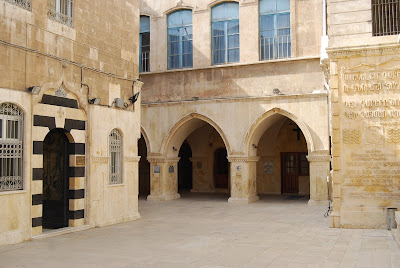 The Armenian Church
The Armenian Church The view of the Mosque from the hilltop Citadel.
The view of the Mosque from the hilltop Citadel. The Citadel.
The Citadel.But this is Syria.
Where the hospitality of its inhabitants are age-old tales passed from travellers to travellers. We were immediately rescued by one person after another (within minutes). The locals pointed us to the right direction and assured us with a smile as big as Arabia itself - "Ahlan wasahlan".
Aleppo to a lot of Westerners is a deeply conservative city but that analysis didn't occur to me until someone actually said it. Yes there are people donning traditional dress but hey they could be physicist or a socialist for all I know. Someone wearing modern Western clothing might hold a traditional worldview (caste system, arranged marriage, honour above all, tribal allegiance etc). Is that conservative or not? The term conservative to me is confusing.
The highlight of Aleppo for me is the tomb of Prophet Zachariah. I was just walking around the Old Town aimlessly when I saw the Omayyad Mosque. I went in, prayed and sat down in the cool shades admiring the elegant architecture of the courtyard. I saw people converging at one corner and I asked someone what they're looking at. When told that it was the tomb of the Prophet I felt a kind of blood rush. I was moved. This was the first time that I actually see any kind of manifestation from the Quran and the prophetic stories. I was really moved by it. I stood there and just stared at the simple grave adorned with rich green textile. I was at peace.
The Aleppine souqs are breathtakingly beautiful. The mediaeval architecture fused with the messiness of the goods creating scenes that took me centuries back. Best of all it wasn't a museum toy town for tourists but an authentic part of the urban fabric. It's a functioning high street. Maybe a good comparison would be Fes in Morocco but there the souqs are more like alleyways. In Aleppo it was an interconnected grand bazaar covered in countless domes. And unlike the Moroccan souqs, there was absolutely no hassling or pushy sellers. I loved the souqs here. I spent hours and hours just walking around getting lost in the labyrinth. Kudos to the enlightened municipal council whose philosophy is to preserve the authenticity of life in the Old City. That would ensure this won't go down as another tourist trap. I went to the regeneration museum to learn more about their plans and was really impressed. Penang and Melaka should learn from Aleppo.
The Christian Quarter was another interesting area in the Old City. I've always been curious about the Christian Arabs. Now that I've learnt a bit more, they're all more intriguing. All of the different churches are concentrated in almost one street in Quarter - Armenian, Maronite, Greek Orthodox and Catholic. Each has its own interesting history in the Arab world. In the Armenian Church I spoke to one lady who showed me around and told me the history of the Armenians in Syria. The Armenians in Syria are mostly descendants of the Ottoman genocide survivors in the early 20th century. She still mourns the loss of Western Armenia (Today's southeastern Turkey) to the Turks and refused to use the Turkish names for these "occupied" areas. I then told her the story of the Armenians in Penang that surprised her. Even told her to come visit Penang.
Aleppo was such a great place, I'd come again for it just to be lost in the souqs or meet up with all the friends that I made here. Even if I didn't do the sightseeing, I would've still enjoyed Aleppo for the sheer friendliness of the people (free falafels, free baklava, everybody wanted a photo with me, I was greeted with songs and the Arab dance in the hammam etc). But Syria is fast modernising. Things seem like it's going to change. But let's hope it will never change the hospitable character of the Aleppines.
I LOVE ALEPPO.







